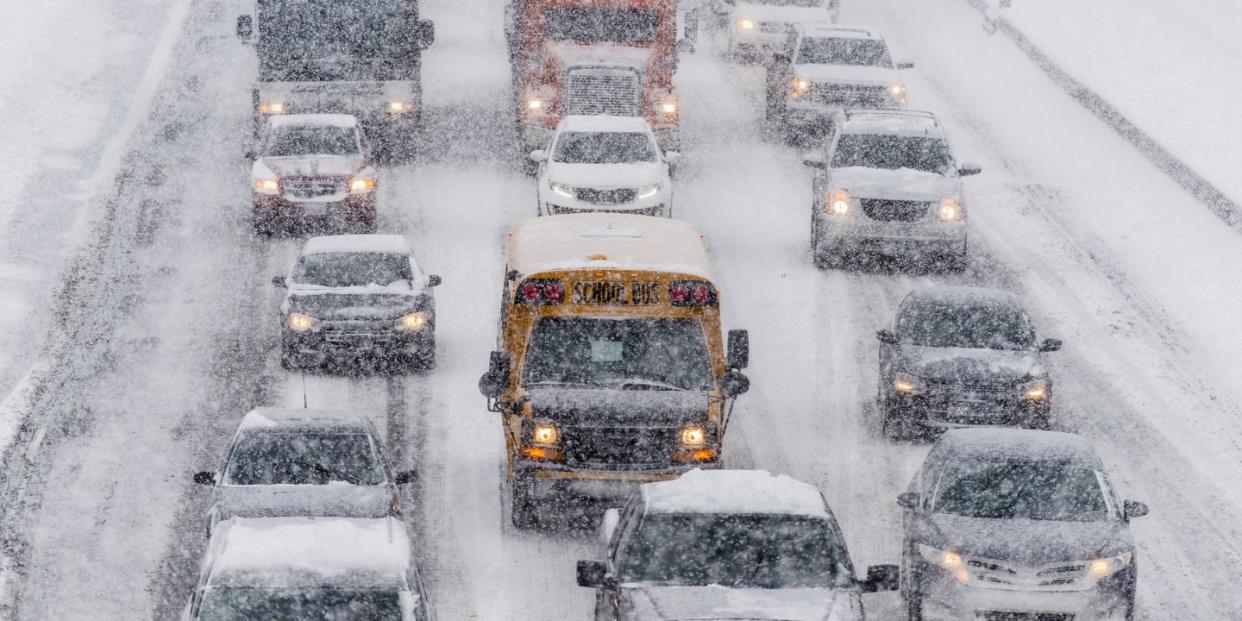What Do You Do If You Get Stranded in an EV in Winter?

Recent extreme winter weather in much of the western U.S.—not to mention a brutal snowstorm in Buffalo, New York, that left dozens dead, some of whom were in their cars—has sparked fresh concerns about what happens to electric vehicle drivers who get stranded in snowstorms. Will they be able to stay warm and safe in their vehicles for any length of time? Or will they need to abandon them at the side of the road and attempt to seek safety elsewhere?
We're here to tell you the heartwarming—literally—truth about your safety when stranded in an EV on the interstate or miles from anywhere in a terrible snowstorm.
EVs Will Keep You Warm
We first addressed this topic a year ago after an alarmist editorial in The Washington Post suggested EVs were more dangerous than gasoline cars for occupants stranded in storms. That's simply not true, and we did the math to explain why.
The facts are these: With a reasonable amount of charge left in your battery, you'll stay warm in your EV for many hours—days, even. If your battery charge is close to zero at the time you get stranded you may have only a few hours of warmth left—just as the gasoline-vehicle driver who gets caught with not much left in the tank.
As always, if you live in snowy regions or are traveling to where epic snowfalls occur it's wise to occur take precautions: bring winter clothes, snacks, water, a shovel for digging a snow cave—no matter what kind of vehicle you're driving. Of course, few of us will probably be that conscientious. Not to worry.
We Tested How Long You Can Stay Warm in an EV
Let's say you're in an EV and you get stranded out on the interstate in blizzard conditions when traffic grinds to a halt. There's nowhere to go until help arrives to clear the road. How long will your EV keep you toasty?
To find out, we tested both a popular electric sedan and its gasoline equivalent to see how long each kind of vehicle can keep you warm. We left the cars outside in Michigan winter weather that averaged 15 degrees and set the cabin temperature to 65 degrees with the seat heaters off. Our testers found that the fully charged EV would keep occupants at that temperature for almost two days—45 hours—while the idling gasoline car that started with a full tank ran for 52 hours.
It's worth noting the EV in question did not even have a heat pump heating system; if it had it would have lasted far longer due to its greater efficiency versus the resistive heating system it was equipped with. Both the gas and electric test cars would also likely have lasted longer if they'd had one or more person inside of them for the duration of the test, since we humans emit heat as well.
As always, the battery capacity of the EV in question—in this case, 80.5 kilowatt-hours—is directly proportional to the length of time the car stays warm. An EV with only a 24.0-kWh pack won't last two days. The EV that Car and Driver used in the test ate 1.6 kWh every hour to produce that heat; you can use that energy consumption figure to do the math to see how long any given EV could keep you warm in a storm. For context, any modern EV with a range of 200 miles or more has at least 60.0 kWh—enough to provide about a day-and-a-half of heat.
Know Thy Car's Heater
Our EV-specific advice on winter heating has two points. First: If you're buying an EV and there's the option of adding a heat pump for the heating system, consider getting it. A heat pump is like an air conditioner that can run in reverse to provide hot air, using both expansion and contraction of a coolant to extract heat from the outside air and warm your car's cabin.
Heat pumps, which are also used in homes, are considerably more efficient than the resistive heating that's standard in some EVs. Resistive systems heat up wires—like some electric baseboard heaters—to emit heat. The gains provided by heat-pump efficiency are mentioned in a study of cold-weather range loss in about 7000 EVs by Recurrent, a telematics data company.
Keep Your EV Charged Up
The second tip for surviving a wintertime stranding is to make sure your EV's battery stays as close to fully charged as possible before you leave home, which is exactly the same advice as telling you to keep the gas tank full before heading out on a trip if a storm is imminent. Whether you're driving a gas car or an EV you want to carry as much energy onboard as possible, whether it will be used to move the vehicle or heat the cabin overnight.
The good news is that the bulk of the miles covered by EV drivers today are fueled via charging at home overnight. Many EVs routinely start each day with a fully charged battery, whereas gasoline cars often do not leave home base with full tanks. There's no need for them to—usually. For that reason, EV drivers arguably have a greater chance that their tank is closer to full when heading into the teeth of a storm.
So what do you do if you're stranded in an EV in winter? The same thing as if you were stranded in a gas-powered vehicle: sit tight, keep the heat at a reasonable level, and wait for help. And if you have some snacks, have at them. EVs can provide potentially days of warmth and comfort in the case of a wintertime stranding—and the same margin of safety that you'd have in a gasoline-powered vehicle.
You Might Also Like


